HOW TO SURVIVE IN THE SEA
Emergency rafts are designed to automatically fill with air upon impact with water. On some older models, the valve needs to be opened, but usually the raft is not inflated while passengers are still on board. Shipowners complete their marine emergency kits, which include all the necessary signaling and navigation equipment, medicines and basic necessities. The rafts should be equipped with external lights that will be visible from passing ships at night, and also have torches, flares and chemical light sources to send distress signals and attract the attention of pilots and crews of nearby ships.
At sea level, the curvature of the Earth manifests itself at a distance of seven nautical miles, that is, about 13 km, but the rocket launcher can send a signal to an altitude of about 300 m, so that pilots and sailors can see it from a long distance.
The rafts are equipped with oars, but you should not make navigation decisions without proper training. Of course, this rule does not apply to those cases when the coast is visible from the raft.
The chances of salvation are best when passengers drop anchor and stay as close to the shipwreck site as possible. From there, most likely at the last moment, distress signals were sent, and they were most likely received by the Coast Guard.
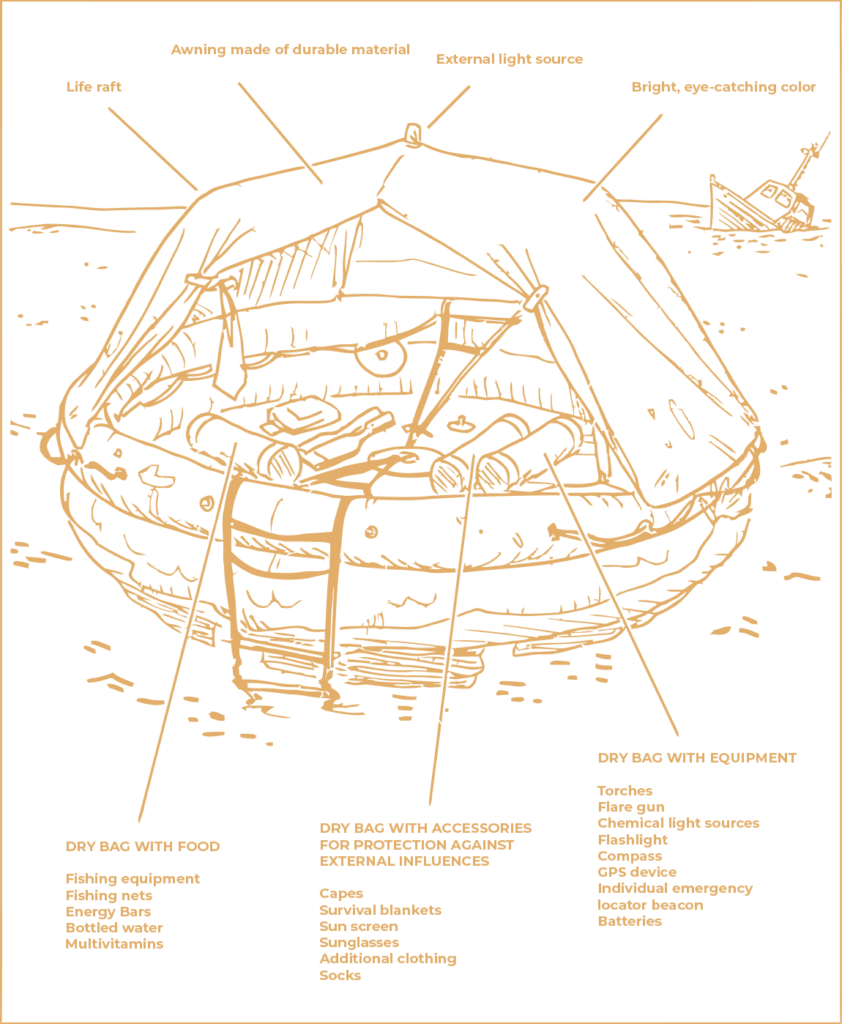
If the GPS device shows that the shore is within 20 km, it is worth trying to head in that direction. However, activate your personal emergency locator beacon, which broadcasts your whereabouts on rescue frequencies. Perhaps this will help you get help faster than getting to shore on your own. In open water, satellite devices are very useful: they have high accuracy and signals are not disturbed by tall buildings or dense vegetation.
Converting seawater into drinking water
There is water everywhere in the sea, but you cannot drink it.
By drinking salt water, you will die even faster than without water at all.
With a penknife or razor and a few easy-to-find items, you can create an impromptu desalination system. Leaving the cap screwed on, cut the bottom of an empty cylindrical bottle for water. The bigger bottle is the better. Bend the bottom of the plastic bottle inward to create a groove more than 5 cm high. Then cut and remove the top of the aluminum beverage can. Fill it with seawater and place it on a hard surface with a plastic bottle on top. The heat will evaporate the water, and these vapors will rise and condense on the inside of the bottle, while the salt will remain inside the can. When drops collect on the plastic wall of the bottle, they will flow down and end up in the gutter you created.
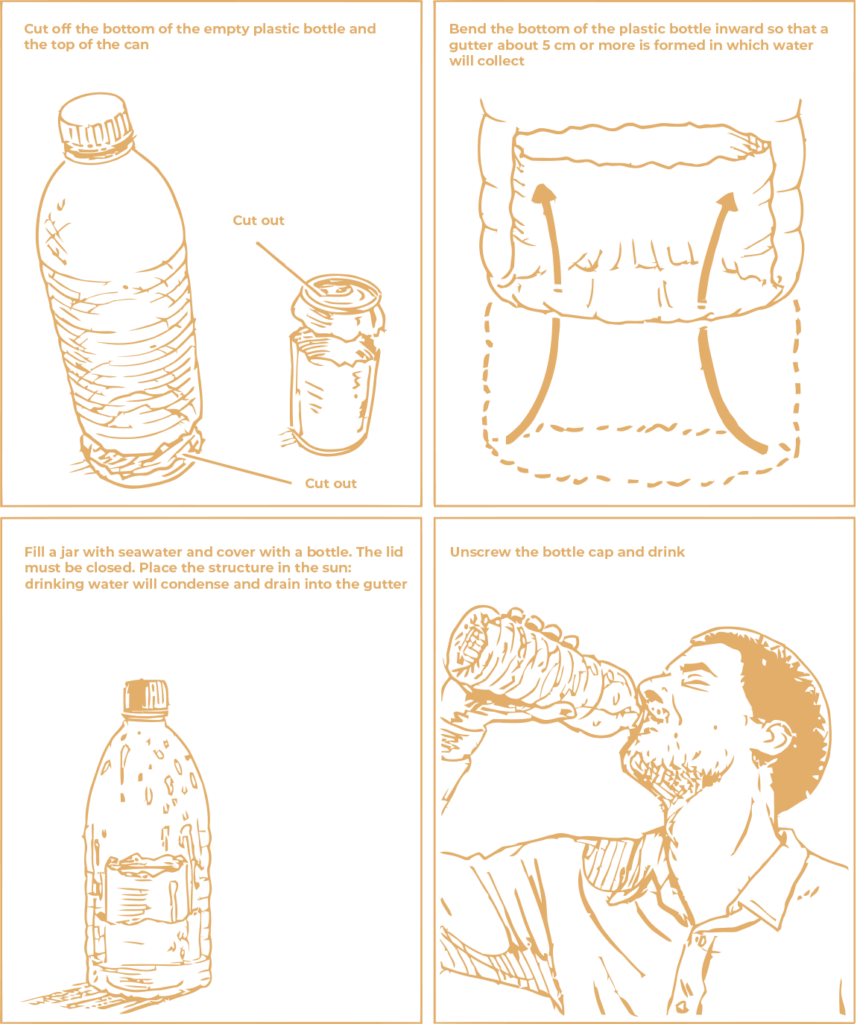
Keep this structure in the sun until enough drinking water has collected in the bottle. Although a person needs to drink about 4-5 liters of water a day to be prepared for emergencies, in the context of survival, you can get by with one liter of water a day, or even less if you can find food with a high moisture content , for example fish and seaweed. If there is no drinking water at all, death will occur in 3-5 days – depending on the temperature of the external environment, the characteristics of the organism and the initial level of hydration.
Replenishing food while drifting at sea
A person can survive without food for 30 days, but the chances of survival will increase if you are lucky enough to catch fish. In the event of a shipwreck, do not use only the emergency supply, in the hope of reaching shore soon.
Immediately start dose the food you have and collect the materials at hand to make a net and / or a set of fishing tackle.
For these purposes, everything clothing you have is suitable – from a shirt to a raincoat or a pair of pants. Tie the sleeves of your shirt to an oar or stick, and tie the bottom in a knot. Dip the shirt into the water so that the fish can swim into your net through the collar.
When making fishing tackle, creativity is very useful. If your emergency food includes canned food or beverage cans that use aluminum pull tabs to open, use them to make hooks. Cut or break off the larger of the tab’s two rings at the midline to create the hook, and thread your fishing line through the smaller ring. All this will have to be done with the help of improvised means. A hook can also be made from a pin needle. During this work, you can use the scissors from the emergency medical kit. As a fishing line, you can use either a thread for cleaning your teeth, or a paracord – a parachute cable made of nylon, which both the military and serious outdoor enthusiasts prefer to take with them.
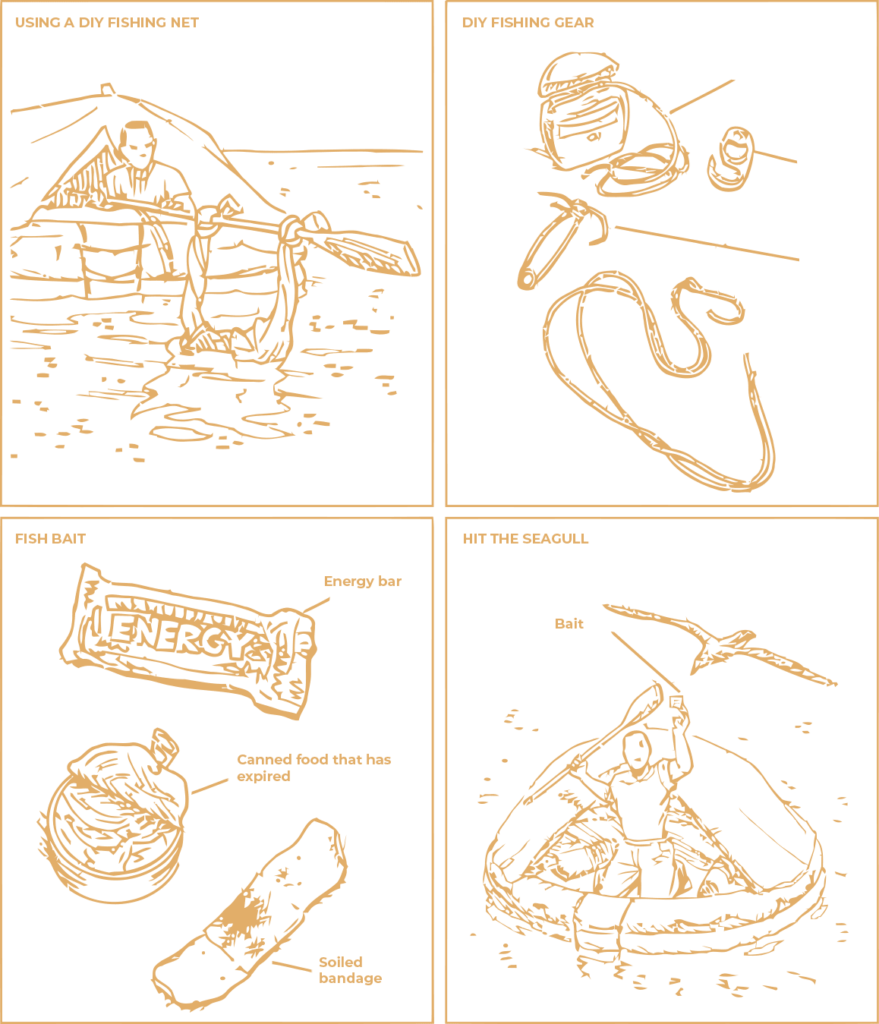
It is also referred to as the ‑ 550 wire rope for its ability to support up to 550 pounds (about 250 kg). It consists of six thinner cords, each of which will support approximately 100 pounds (40 kg). The seagull you see most likely means that the land is close, but the land may be uninhabited. Therefore, any animal, fish or bird should be considered as a potential food product. While the chances of a successful capture of a seagull may seem slim, there are several cases in the history of shipwrecks where survivors have succeeded.
Manufacturing of a floating craft
Even at a water temperature of 15–20 ºC, you run the risk of becoming a victim of hypothermia. Long before your muscles are tired of water resistance, disorientation and a lack of muscle coordination will result. And when strength diminishes, it is vital to have a watercraft.
In the event of a shipwreck, stay as close to the wreck of the sunken ship as possible. The alarm signal given by the ship’s crew can be received by the coast guard, after which the nearby ships will go to the place of the shipwreck.
If you find yourself in the water without a life raft, use the items left after the disaster. Collect some large jars, barrels, or any other empty containers. By tying them together, you get a homemade buoy You can hold bottles over the water or tuck them into your clothing after you drink the contents and close the lids tightly again.
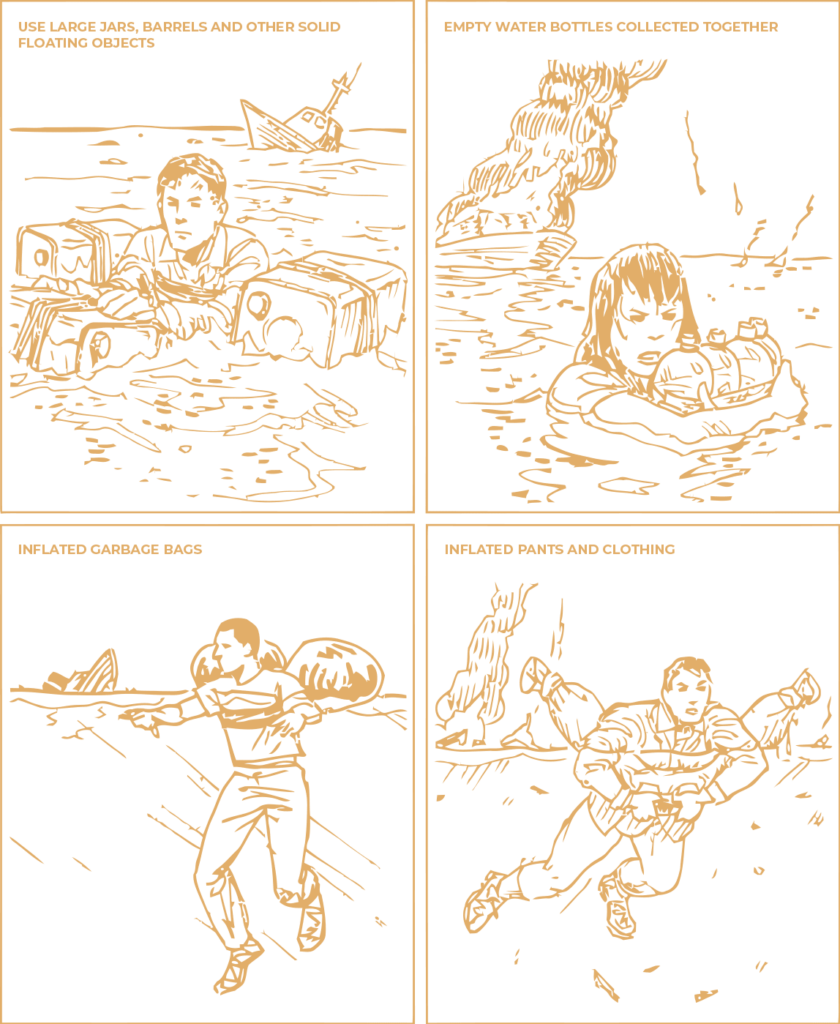
Easily inflated trash bags are also great for this purpose. Clamp the holes with your hands and submerge the bags in the water so that you get inflated floating balls. Even trousers can become an improvised floating craft – many graduates of intelligence schools are familiar with this survival technique. You need to knot the lower parts of the legs and zip the fly (with a zipper or buttons). Then, holding the trousers by the belt, move them forward so that the belt keeps air in the trousers before it touches the water, preventing it from coming out.
Shark attack survival
Despite many frightening stories, sharks rarely attack humans.
On average, worldwide, the number of shark attacks that end in the death of people per year does not exceed 10, and the total number of such attacks does not reach a hundred.
Often everything is limited to one bite, after which the predator swims away in search of food with a higher fat content. But even one bite can be fatal – with serious damage or severe bleeding. Sometimes, after an attack, sharks block the victim, preventing it from swimming away. In this case, you should hit her in the nose or try to tear off the gills.
If you suddenly find yourself in shark-infested waters, stay upright, otherwise you will become a larger and more visible target for predators in the water. For this reason, surfers are often targeted by sharks.
It is hypothesized that sharks are scared off by the sounds made by the Dräger rebreathers worn by US Navy SEALs.
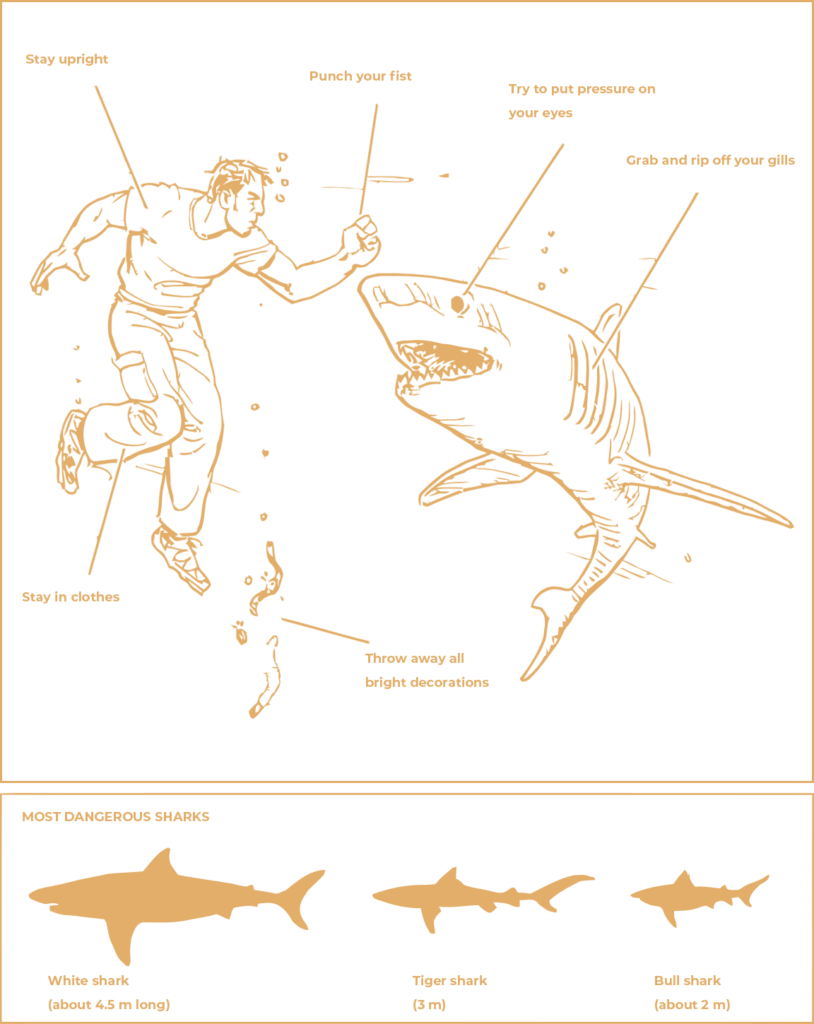
Scouts – saboteurs often encounter predators in the deep seas, but are generally not attacked. Although this hypothesis remains untested, it is worth trying to make noise using metal or glass objects if sharks are circling around you and rescue seems unlikely. Keep in mind that shiny metal decorations that reflect sunlight will attract these curious fish. In an emergency, use the ironic advice of the SEALs: «See a shark? Stab and swim away faster as you can».






